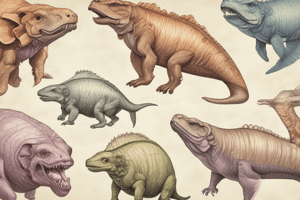Podcast
Questions and Answers
What is the size range of conodont elements?
What is the size range of conodont elements?
- 0.25 to 2.0 mm (correct)
- 0.1 to 1.0 mm
- 1.0 to 10.0 mm
- 0.5 to 5.0 mm
What is the geological time period when conodonts are most commonly found?
What is the geological time period when conodonts are most commonly found?
- Cambrian (correct)
- Ordovician
- Pre-Cambrian
- Triassic
What is the term used to refer to the complete conodont animal?
What is the term used to refer to the complete conodont animal?
- Element
- Vertebrate
- Conodont (correct)
- Chordata
What is the length range of conodont animals?
What is the length range of conodont animals?
When did the conodont-bearing organisms become extinct?
When did the conodont-bearing organisms become extinct?
What is the composition of conodont elements?
What is the composition of conodont elements?
Where were the very well-preserved conodont species found?
Where were the very well-preserved conodont species found?
What is the current understanding of the conodont's affiliation?
What is the current understanding of the conodont's affiliation?
What is the purpose of the conodont color alteration index (CAI)?
What is the purpose of the conodont color alteration index (CAI)?
What is the significance of conodonts in the Paleozoic age?
What is the significance of conodonts in the Paleozoic age?
What is the role of temperature in the distribution of conodonts?
What is the role of temperature in the distribution of conodonts?
What is the size range of calcareous nannoplankton?
What is the size range of calcareous nannoplankton?
What is the composition of calcareous nannoplankton?
What is the composition of calcareous nannoplankton?
When did the first records of calcareous nannoplankton appear?
When did the first records of calcareous nannoplankton appear?
What is the significance of conodonts in the context of hydrocarbon exploration?
What is the significance of conodonts in the context of hydrocarbon exploration?
What is the possible trophic character of conodonts?
What is the possible trophic character of conodonts?
What is the characteristic structure of Haptophyta algae?
What is the characteristic structure of Haptophyta algae?
What percentage of total chlorophyll biomass in oceans do haptophyte algae occupy?
What percentage of total chlorophyll biomass in oceans do haptophyte algae occupy?
What is the primary function of coccolithophores in the geological process?
What is the primary function of coccolithophores in the geological process?
What is the size range of coccoliths in coccolithophores?
What is the size range of coccoliths in coccolithophores?
What is the primary composition of coccoliths?
What is the primary composition of coccoliths?
What is the primary difference between heterococcoliths and holococcoliths?
What is the primary difference between heterococcoliths and holococcoliths?
What is one of the theories explaining the function of coccoliths for the organism?
What is one of the theories explaining the function of coccoliths for the organism?
What is the name of the structure formed by the secretion of coccoliths in coccolithophores?
What is the name of the structure formed by the secretion of coccoliths in coccolithophores?
Study Notes
Conodonts
- Conodont elements are phosphatic tooth-like structures with affinity to an extinct early vertebrate, composed of calcium carbonate fluorapatite with additional organic matter, ranging in size from 0.25 to 2.0 mm.
- Five major functional types of conodont elements can interpret trophic characters, suggesting whether conodonts were suspension feeders, detritus feeders, or predators.
- The biological affinity of conodonts was debated, but they are now believed to be an extinct group of primitive jawless vertebrates belonging to the Chordata.
Paleoecology
- Provincialism in conodont assemblages suggests temperature was an important control factor in their distribution.
- Oxygen isotopic data indicates conodonts lived in warmer seas, tolerating temperatures above 40°C.
Applications
- Conodonts are a widespread and biostratigraphically important group of microfossils for the Paleozoic‒Triassic strata.
- The alteration of conodont elements, expressed as the “conodont color alteration index (CAI)”, is an indicator of thermal maturity of a source rock, useful in basin analysis for hydrocarbon exploration.
Calcareous Nannoplankton
- Calcareous nannoplankton, including coccoliths, discoasters, and nannoconids, represent a major component of oceanic phytoplankton, ranging in size from 0.25 to 30 μm.
- They are found in fine-grained pelagic sediments in high concentrations, with calcareous skeletons forming a significant rock-forming process.
- The first records of calcareous nannoplankton are from the Late Triassic.
Coccolithophores
- Coccolithophores are a dominant marine primary producer in modern oceans, occupying 30–50% of total chlorophyll biomass in oceans.
- They contribute to the reserve of atmospheric CO2 as limestone through sedimentation of calcified cells throughout geological time.
- Coccoliths are made up of calcium carbonate, mostly as calcite, and to a lesser extent as aragonite.
- There are two types of crystallization: heterococcoliths with varied shapes and sizes, and holococcoliths with similar types of unmodified or slightly modified rhombohedral or hexagonal crystals.
- Theories suggest coccoliths either shield the cell from excessive sunlight or concentrate light towards the interior for photosynthesis.
Studying That Suits You
Use AI to generate personalized quizzes and flashcards to suit your learning preferences.
Description
This quiz explores the functional morphologic analysis of conodont elements and their potential to interpret ancient ecosystems. It covers the five major functional types of conodont elements and their characteristics.




